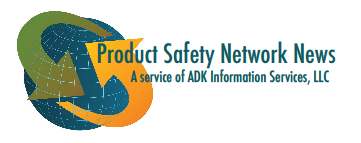Company maintains light’s safety despite growing reports of fires
May 10, 2017, Fox8 News
The number of local reports of the Ever Brite solar-powered LED light spontaneously catching fire is growing, while the company behind the product maintains that it is safe. Other consumers have complained about the same thing happening with the product across the country. In the last year, at least five people have reported the problem to the U.S. Consumer Product Safety Commission.
California Proposition 65 settlement requires strict reformulation for cadmium necklaces
May 5, 2017, Open PR
A new California Proposition 65 (Prop 65) settlement agreement has been reached concerning the use of cadmium in necklaces. Agreed in March 2017, the settlement requires a reformulation of cadmium content to no more than 100 ppm. This is considerably lower than the 300 ppm previously agreed in a national, legally binding settlement concerning jewelry, concluded on March 22, 2011.
CPSC Commissioner Mohorovic on the Commission’s proposed mandatory rule regarding table saws
April 27, 2017, cpsc.gov
Commissioner Mohorovic explains why “unfortunately I was unable to join” in a decision to issue a Notice of Proposed Rulemaking to address blade-contact injuries among users of table saws. He notes that specific technology is available that can reduce risk in this instance. Where such factors exist, he notes “government should respect consumer choice and individual liberty, (and) allow consumers to decide for themselves what risks they will tolerate.
Risky residences: Latest recall trends show surge in household product incidents and injuries
May 9, 2017, PR News Wire
The Q1 2017 Recall Index from Stericycle ExpertSOLUTIONS found that while the number of consumer products recalled decreased compared to Q4 2016, products for the home and family posed disproportionate dangers. Just four household product categories accounted for more than 75 percent of all consumer products recalled: home furnishings/fixtures, housewares, toys, and child nursery equipment and supplies. At the same time, the risks of people falling, bleeding, or choking accounted for nearly 75 percent of the top hazards reported.
Our View: Take a step back on rubber mulch
May 11, 2017, Duluth News Tribune
Now that estimates have come back at more than triple the originally talked-about cost, can the Duluth School Board please do right by taxpayers and take a step back on replacing rubber mulch on school playgrounds — at least until the science is there to tell us if the stuff is even a problem? Concerns about the soft play surface material started brewing around 2008. A number of studies quieted the controversy but never quite quelled it.
What parents need to know about the spike in child product safety recalls
May 9, 2017, JDSupra
A recent report published by Kids in Danger (KID), a non-profit group, indicates that child product safety recalls rose in 2016 over the previous year, peaking to its highest level since 2004. The analysis looked at data provided by the U.S. Consumer Product Safety Commission (CPSC) from 2016, revealing that companies pulled 66.8 million units of 76 child products from store shelves.
EU Council publishes directive on the safety of toys with lead
May 6, 2017, UL
The Council of the European Union has published a Council Directive (EU) amending, for the purpose of adapting to technical progress, Annex II to Directive 2009/48/EC of the European Parliament and of the Council on the safety of toys, as regards lead on April 27, 2017. The Directive sets 3 limits for lead in toys, and comes into force May 18, 2017.
Bio-on bio plastic analyzed by Italian Toy Safety Institute to verify product safety for children
May 3, 2017, nasdaq.com
The Italian Toy Safety Institute(Istituto Italiano Sicurezza dei Giocattoli – IISG, a UL company) has run specific analyses on tested samples of Minerv Supertoys, the new type of PHAs bio plastic designed and developed by Bio-on for the toys of the future, and has issued its declaration of conformity. Like all the PHAs bio plastics developed by Bio-on, the special grade Minerv Supertoys is 100% natural and biodegradable.
China drafts list of substances restricted in consumer products
May 4, 2017, Chemical Watch
China’s National Consumer Product Safety Standardisation Technical Commission has consulted on a draft list of substance restrictions in consumer products.The list combines a number of existing Chinese standards and, where no domestic standard exists, it refers to restrictions based on EU and other foreign legislation. The draft – which is similar to the consumer restrictions set out in the EU’s REACH Annex XVII – includes 103 chemicals and proposes limit values for their use in consumer products such as toys, textiles, coatings, paints, decoration materials and furniture.
Product safety lowest in India among world’s top 4 markets, yet brand rules
May 10, 2017, Times of India
India has the highest proportion of people who are worried about the safety of consumer goods, especially children’s products and food items. This is because among the world’s top four consumer markets, including US, China and Germany , it is in India that consumers have suffered the highest number of product safety incidents in the last five years, with allergic reactions being the top issue, followed by cuts from sharp edges and food poisoning.
In Flint, overdue bills for unsafe water could lead to foreclosures
May 4, 2017, The New York Times
Following a water crisis that saw sky-high levels of lead contamination in Flint, Mich., many homes in the city still do not have access to safe tap water.But that doesn’t mean they’re not being charged for it. And if they can’t pay in time, they may lose their homes. The city has mailed 8,002 letters to residents in an effort to collect about $5.8 million in unpaid bills for water and sewer services.


